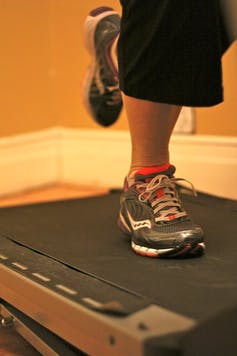Spinal cord injury: big hope is cell therapy but exercise is best for now

It's still early days for cell therapy. Michael Dorausch/Flickr, CC BY-SA
You might have heard about Darek Fidyka, the paralysed man from Poland who recently walked again after an experimental cell transplant. It made headlines around the world and raised the hopes of many people with spinal cord injuries that they too might one day have their movement restored.
But while early research suggests cell therapy could be used to treat spinal cord injury, it’s still very early days. For now, exercise therapy holds the best promise for recovering movement.
What are spinal cord injuries?
Each year nearly 400 Australians sustain a spinal cord injury. One in three injuries occur in young people between 15 to 24 years old and are usually caused by motor vehicle accidents. Around 12,000 Australians are living with a spinal cord injury, most (84%) of them men.
The extent of damage to the spinal cord and where it occurred determines the severity of injury. An injury can be either “complete”, meaning no sensation or movement below the area of spinal cord damaged, or “incomplete”, where some sensation and movement are still present below the injury.
Injuries to the neck will result in a paralysis of all four limbs (quadriplegia), whereas injuries below this level will result in varying degrees of paralysis from the legs up to the abdomen (paraplegia).
Spinal cord injury often also affects other areas of the body. Bladder and bowel control can be affected, as well as the ability to breathe independently. Nerve damage associated with the injury can lead to persistent pain and uncontrollable muscle spams.
The long-term effects of spinal cord injury can be devastating.
Emerging therapies
The most impressive research poised to change the future of spinal cord injury treatments are stem cell therapies and implanted spinal cord stimulators.
Recent research has shown that injections of a particular type of stem cell from the nose, called olfactory ensheathing cells (OECs), has helped reconstruct a damaged spinal cord and allowed paralysed man Darek Fidyka to walk again.
OECs are specialist cells that repair nerve cells involved in our sense of smell. They sit at the base of the brain and are harvested from deep in the nasal cavity. When doctors injected the patient’s own OECs onto a nerve graft across the injury site the injured spinal cord regenerated across the gap.
Although the severed spinal cord was repaired five weeks after the surgery, it took a further 19 months of intensive exercise therapy before sensation and voluntary movement were regained in Fidyka’s legs. After a further six months of therapy, he has regained a limited ability to walk with braces and a walking frame.
Another promising therapy comes from a team of American researchers. Using a combination of intensive step training and stimulation of the spinal cord, via electrodes implanted below the injury, five people with spinal cord injuries have recovered the ability to stand and walk.
However, scientists still don’t understand exactly how spinal cord stimulation contributes to the regained movement ability.
These discoveries are in the early stages and it may be many years until the potential therapies are widely available to patients.
For now, simple is best
The common intervention used in both of these emerging therapies is surprisingly simple and yet incredibly effective: exercise. OEC transplants and spinal cord stimulators are each used alongside exercise therapy to try to improve the efficiency of this already very successful treatment.
Specialised exercise training, usually in the form of assisted step training on a treadmill, is by far the most beneficial treatment currently available. It results in significant improvements in standing and walking after spinal cord injury.

Exercise therapy can improve movement.
M Car/Flickr, CC BY-ND
Most people with spinal cord injuries have some undamaged nerves left around the area of the injury. Exercise training encourages the residual nerves to sprout and form a functional “bridge” around the area of damage.
Early intervention is best, but significant improvements can be achieved even if training begins years after the injury. Impressively, patients can maintain their walking ability long after the training sessions are completed.
The major downfall of exercise therapy is that it needs to be intense (at least 60 minutes per day) and ongoing (60-plus sessions). Greater training time results in better recovery. Unfortunately, the expense and limited availability of this intensive therapy can mean it is inaccessible for many.
The future for treatment after spinal cord injury is indeed very exciting and full of promise, but right now exercise is still the best medicine on offer.

Michelle Rank receives funding from The National Health and Medical Research Council and SpinalCure Australia.







